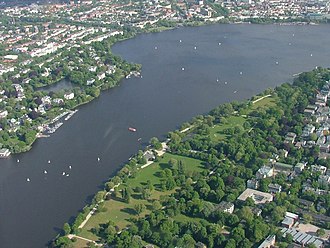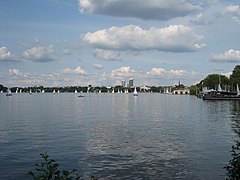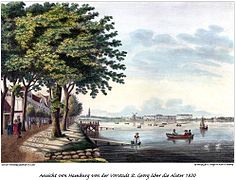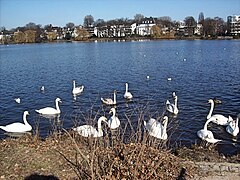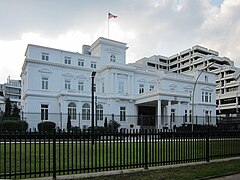Alsterpark
The Alsterpark runs along the banks of the Alster around the Outer Alster and includes the Schwanenwik, Eduard-Rhein-Ufer and Alster foreland areas. Starting in the south, the park runs east through the districts of St. Georg , Hohenfelde , Uhlenhorst and Winterhude , from the Krugkoppelbrücke west through the Alster foreland in Harvestehude and Rotherbaum to the Kennedybrücke at the transition to the Inner Alster .
location

At the southern tip of the artificially dammed Alster Lake, the Alsterpark in the St. Georg district is divided into two areas - on the banks of the Alster along the Kennedy Bridge and as a green space between the Kennedy Bridge and Lombard Bridge . There is an underpass between the outer and inner Alster for pedestrians and cyclists. The Gurlittinsel is located on the bank along the street An der Alster . The Alsterpark Hohenfelde crosses the Schwanenwik connection , and the Uhlenhorst district and the Eduard-Rhein-Ufer begin along the Schöne Aussicht street north of the Mundsburg Canal . Winterhude is reached via Herbert-Weichmann-Strasse and the Langenzugbrücke . On the bank along the streets Bellevue and Fernsicht in the direction of the Krugkoppelbrücke you reach the northern bank. The Harvestehuder Weg leads through the Alster foreland on the western bank in the Harvestehude district. The Alsterufer street leads through the Rotherbaum district back to the Kennedy Bridge . The Alster circuit around the Outer Alster is a popular running route for joggers and is around 7.4 km long.
The eastern bank
Alsterlust
The eastern bank begins at the Kennedy Bridge in the St. Georg district. If you cross the bridge named after John F. Kennedy , you cross the 10th degree of longitude, a marking on the bridge shows the meridian . Immediately behind the bridge is one of the few remaining sculptures that took place in the Alsterpark during the exhibition "Plastic in the Park" for the 1953 horticultural exhibition. It comes from Max Bill and is called “Rhythm in Space”. The Alster and the Alsterpark have drawn people for hundreds of years and invited people to “stroll” - that's what they called walking and strolling along the banks of the Alster. Boat trips were "pleasure trips" and swimming was very popular. On the bank in front of the Atlantic Hotel, a bathing area was first built, which was later converted into a public bathing establishment and called it "Alsterlust". A little further there is a small bridge. It leads to the Gurlittinsel , a small rock island with a sailing school and a rowing club right in the water. Boating is a tradition and there are several boathouses, rowing clubs and sailing schools in the Alsterpark.
Granite from Max Wunderlich
Schwanenwik
The name Schwanenwik is derived from "Swan Bay". This meant the Hohenfeld Bay - a favorite place of the Alster swans, which in Hamburg are particularly protected by the "swan nature". The Alster swans are a landmark in Hamburg and have their own quarters at the Eppendorfer Mühlenteich over the winter, where they are particularly cherished and cared for by the swan father. Schwanenwik is the name of the road along the shore that was built between 1853 and 1858 as a connecting route between St. Georg and Uhlenhorst. The Literaturhaus Hamburg lies on her . The monument to Wolfgang Borchert is at about the same height on Parkweg . His post-war drama “ Outside the Door ” premiered the day after his death at the Hamburger Kammerspiele . Often the name Schwanenwik also refers to the large meadow in the Alsterpark. There was another public bathing establishment here until the 1920s. During the Second World War, a jetty led from the bathing establishment to an anti-aircraft battery in the Outer Alster (“Mayor Krogmann position”), which was supposed to protect service villas of the Nazi system around the Alster from air raids. The monument by Edwin Scharff - “Three men in a boat” and a memorial stone on the Schwanenwik meadow commemorate three fallen soldiers in World War II who were deployed on this anti-aircraft battery.
The Eduard-Rhein-Ufer
The Eduard-Rhein-Ufer begins at the Alster-Perle along the Schöne Aussicht street in Uhlenhorst. The founder , inventor and editor-in-chief of the “Hörzu” program guide, Eduard Rhein , lived on this street. At the Feenteichbrücke to the north on the right is the Feenteich with the Senate guest house . At the end of the Eduard-Rhein-Ufer are the North German Regatta Club and the Rowing Society Hansa eV Opposite is the Islamic center with the blue Imam Ali mosque . The new building for the “Double Triangular Pavilion for Hamburg” by Dan Graham is located on a large meadow at the transition to Fährhausstrasse . A walk-in glass pavilion in the meadow, in which the sunlight is reflected in a special way. The Lange Zug , an offshoot of the Osterbek, separates the two districts of Uhlenhorst and Winterhude.
Bellevue and distant view
Bellevue street ends on the eastern bank of the Alster. Many city villas surround the Alsterpark in the Winterhude district and shape the street scene. The park runs right on the banks of the Alster, benches and lawns are right next to the water covered with water lilies. From the Fernsicht street you have a view of the entire Outer Alster. The Krugkoppelbrücke and the Fernsicht street form the northern bank and the connection to the western bank of the Alster. The Rondeel Canal branches off at Fernsicht, the Krugkoppelbrücke leads over the Alster Canal.
The western bank
The Alster foreland
The Alster foreland in Harvestehude begins on Harvestehuder Weg west of the Krugkoppelbrücke . Originally there was pastureland here. Plans to create a public park here already existed at the end of the 19th century. The plan could be implemented for the international horticultural exhibition in 1953. Before that, private garden plots, some of which reached the shore, were bought back, and some were also expropriated. The international horticultural exhibition took place at the same time in Planten un Blomen. In the Alster foreland, the exhibition "Plastic in the open" was to take place in parallel. The Hamburg garden and landscape architect Gustav Lüttge was commissioned to design a public park from the Alster foreland. He built paths and a pond with a bridge; the Japanese lanterns were added later. In the north-western part a promenade with small walls was created to demarcate the raised beds. There was space here for the sculptures on display. Also on the meadow and in other areas of the Alsterpark around the shore, sculptures and sculptures were artfully staged. The idea arose to make art accessible to people in public spaces and paths without having to enter a specific building or having to pay admission. The paths laid out have been preserved to this day - some with small walls, the pond with a bridge and the trees. Special trees from this period are the American sweetgum tree and the trumpet tree - both were planted in 1950 and the Caucasian wing nut from 1930. It is located directly in front of the Alster ship jetty at Fährdamm. Some of the sculptures have changed location, new ones have been added. With the opening of the horticultural exhibition, this part of the Alsterpark was ceremoniously presented to the public.
Promenade in the Alsterpark designed by Gustav Lüttge
Thomas Stricker meteorite workshop
The Alsterufer in Rotherbaum
The Rotherbaum district begins at the ferry dam and the Alster foreland merges into the Alsterufer . Here the park path leads directly along the shore and most of the benches are right by the water. The police station of the water police is located at the Rabenstrasse pier. Imposing houses also form the backdrop for the Alsterpark. On the opposite side of the street is the war memorial of the second infantry regiment 1870–71 by Johannes Schilling on a marble plinth with a stone enclosure. The memorial stone for John Fontenay , merchant and shipowner and namesake of the streets of the same name is located on Fontenay Street. The street Alsterufer , on which the Germania rowing club presents itself with a new building, leads to the southern bank of the Alster and back to the Kennedy Bridge in the St. Georg district.
Monuments and sculptures

Many monuments and sculptures adorn the Alsterpark on the meadows and paths around the shore. Some still come from the aforementioned exhibition “Plastic in the Open”, others from the “Art in Public Space” program. Well-known works are: "Four men on buoys" by Stephan Balkenhol from 1993. One of his figures is on the Alster at Schwanenwik. The bronze "Children let flying kites" from 1963 comes from Gerhard Brandes . The "Big Standing Woman" from 1958 is by Jörn Pfab. The two-part sculpture "Orpheus and Eurydice" was made in 1958 by Ursula Querner . Metal thieves stole Eurydice and the sculpture was incomplete for a long time and gained notoriety as an art theft. On the Alte Rabenstrasse there is a street sign with a raven sculpture from the 19th century on a frame. The sculpture is by Franz Andreas Meyer . Manfred Ritthoff-Linau created the sculptures “With a View of the Lake” from 1991, “The Guardian of the Swamp” from 1993 and “The Stranger on the Water” from 1995. His sculptures are all on the eastern bank of the Alster.
building
There are many eye-catching buildings around the Alsterpark - this of course includes the many Alster villas along the Schönen Aussicht , Bellevue or on Harvestehuderweg . But also hotels like the Atlantic or the consulates like the American Consulate General are located here. The banks of the surrounding streets are usually undeveloped, exceptions are buildings that were built before the international horticultural exhibition in 1953 or the many boathouses and rowing clubs with their club houses, kayak and pedal boat rentals or sailing schools. The Anglo-German Club is regarded as apolitical and advocates German-British, but also international business relationships. The building is located directly on the park on Harvestehuder Weg near the Krugkoppelbrücke and was built by Martin Haller in 1860 . On the eastern bank is the blue Imam Ali mosque and the Islamic center. Former toilet houses within the park have been converted and are used for catering purposes, the toilets can be used by all park visitors for a fee during opening hours.
Ferry dock
There are some Alster-Touristik GmbH piers within the park. The white fleet runs regular liner services with several ships on the Outer Alster. Alster-Touristik is not a member of the Hamburger Verkehrsverbund and the company's current fares apply. The Atlantic pier is located on the eastern bank in the St. Georg district in front of the hotel of the same name and the Uhlenhorster Fährhaus pier in the Uhlenhorst district . The Krugkoppelbrücke pier is on the northern bank, and the two pier Fährdamm in Harvestehude and Rabenstrasse in Rotherbaum are on the western bank . The Rabenstrasse pier with its Art Nouveau bridge was built at the beginning of the 20th century and is a listed building. Right next to it is the police station of the water police with their service boats and their own pier.
sport and freetime
Rowing has a long tradition on the Alster, the Hamburger and Germania Ruder Club is the oldest in Germany and the second oldest in the world. White sails are also part of the Alster and various sailing schools offer courses. Anyone who sails outside of a club has various options in the Alsterpark to launch their own rowing boat or kayak. Pedal boats can be rented at various locations. Stand-up paddling has become increasingly popular in recent years. The Alster circuit is a popular route for joggers. In all districts of the Alsterpark there are measuring stations that use a chip on the running shoe and an induction loop in the floor to monitor your own mileage. The number of measuring stations passed is freely selectable depending on fitness and activation of the chip. There are fitness machines with display boards for various exercises in many parts of the park. The paths in the park are ideal for Nordic walking and various gymnastics, yoga and similar courses take place in the meadows. A permanently installed slackline for training balance and coordination is located on the large meadow near the ferry dam. Hamburg-Wasser donates free drinking water, a dispenser is located on the Fährdamm.
Furnishing
Numerous benches, some directly on the water, invite you to linger. In summer, white-lacquered wooden armchairs are distributed over the green area of the Alster foreland. The visitors can place and group them as desired. The Eimsbüttel district office is responsible for the Alster chairs. They were first displayed on the occasion of the International Horticultural Exhibition in 1953. Since then they have been called the Alster chairs in Hamburg. But you can also see them in other parks. Of 140 Alster chairs at the end of the 1990s, 20 were still available at the end of 2017. The district office welcomes donations and is happy to accept chair sponsors. The promenade, laid out by the Hamburg garden and landscape architect Gustav Lüttge, contains seated walls, and sculptures of Japanese lanterns are located by the pond. There is no playground, there are a few devices for children on Eduard-Rhein-Ufer. There are bike rental stations on the western and eastern banks. Cycling within the park is only allowed on signposted cycle paths, in the western part of the park only on the newly established cycle road on Harvestehuder Weg. There are grill areas on Schwanenwik and on the north bank on Fernsicht street. There are dog exercise zones on Fährhausstrasse and Fährdamm in Harvestehude.
nature
The white mute swans are called Alster swans in Hamburg . You have been at home in and on the Alster for hundreds of years and are among the residents of the Alsterpark. Until 1955, the swans had their winter quarters at Schwanenwik in Hohenfeld Bay, which is why the water basin there was sometimes called the swan pond. Their winter quarters have been at the Eppendorfer Mühlenteich since 1955. The Hamburg swan system is both the oldest and smallest authority in Hamburg, it consists of just one person, the swan father. The gray geese are also numerous residents of the Alsterpark, the large meadows on Schwanenwik or the Alster foreland are among the favorite places. Reeds and bulrushes were planted for the waterfowl and fish, bald cypresses and weeping willows on the banks provide shelter and breeding grounds. Coots , great crested grebes and mallards can be seen year round. Bats can also be seen at dusk . In addition to linden , oak and maple trees , there are some exotic trees in the Alster foreland . Some of them still come from the previous owners of the former garden plots, and some of them were planted for the upcoming international horticultural exhibition in 1953. The exotic trees include the ginkgo tree (1996), the mountain sequoia tree (1960), the bluebell tree (2004), the Japanese cake tree (1970), the tulip tree (1935), the trumpet tree (1950), the American sweetgum tree (1950), the Caucasian wingnut (1930) and bald cypress (1952); in brackets the year of planting according to the list of district offices. The oldest tree is the Japanese pagoda tree , it is located on a green area on the bank of the Alster, the year of planting is stated to be 1885. Every year in May, the Japanese community thanks fireworks with fireworks for the hospitality and to greet the cherry blossom.
Others
The Alsterpark is part of the Outer Alster ensemble and, like the Alster itself, is a listed building. In particular, under No. 29524 in the Eimsbüttel district, the designs by Gustav Lüttge - park pond with bridge, walls, stand areas for the sculpture exhibition and parks are mentioned.
literature
- Frank Peter Hesse: The Alsterpark. History and shape. On the death of Gustav Lüttge 25 years ago. In: The garden art . Vol. 5, No. 1, 1993, pp. 135-158.
- Around the Alster. Authority for Environment and Energy, as of 2016 District Offices Hamburg-Mitte, Nord and Eimsbüttel ( online )
Web links
- The Alster is the heart of the city. ( Memento from October 10, 2011 in the web archive archive.today )
- Hamburg Architecture Archive, Gustav Lüttge
Individual evidence
- ↑ a b Outer Alster. Retrieved December 18, 2018 .
- ↑ a b running in Hamburg - Alster round, Hamburg. Retrieved December 19, 2018 .
- ↑ 10. Longitude in Hamburg | Kulturkarte.de - cultural map of Hamburg. Retrieved December 19, 2018 .
- ↑ Max Bill: Rhythm in Space | ART @ SH | Schleswig-Holstein & Hamburg. Accessed December 19, 2018 (German).
- ↑ History | Hamburg swans. Accessed December 20, 2018 (German).
- ↑ The swan being | Hamburg swans. Accessed December 20, 2018 (German).
- ↑ The Flak Island on the Alster. Retrieved December 20, 2018 .
- ↑ Rowing Hamburg - Rowing Society HANSA eV Accessed on December 21, 2018 (German).
- ^ Art in public space. Retrieved December 21, 2018 .
- ↑ Outer Alster. Retrieved December 19, 2018 .
- ↑ Hamburg Architecture Archive - home page. Retrieved December 21, 2018 .
- ^ World of Form> Sculpture in Public Space> Hamburg. Retrieved December 21, 2018 .
- ^ Sculptures: Querner, Ursula in Hamburg | Kulturkarte.de - cultural map of Hamburg. Retrieved December 26, 2018 .
- ↑ History & Tradition | The club. Accessed December 27, 2018 (German).
- ↑ Stand Up Paddling SUP. Retrieved December 27, 2018 .
- ↑ Friederike Ulrich: Where are the Alster armchairs? In: Hamburger Abendblatt. June 13, 2013, p. 9.
- ↑ Pictures of the week: Stay away from the Alster chairs! In: THE WORLD . June 16, 2013 ( welt.de [accessed December 27, 2018]).
- ↑ Ulrich Gaßdorf: Consuls donate Alster chairs . In: Hamburger Abendblatt. October 24, 2017, p. 15.
- ↑ Around the Alster. (PDF) Environment and Energy Agency, April 2016, accessed on December 28, 2018 .
- ↑ »Alsterachsen«: Harvestehuder Weg bicycle road inaugurated. Retrieved December 27, 2018 .
Coordinates: 53 ° 34 ′ 28 ″ N , 10 ° 0 ′ 3 ″ E
